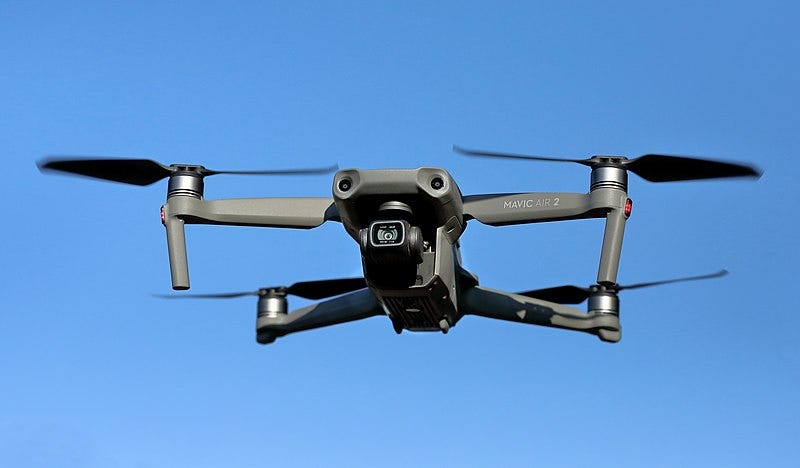China isn't letting Russia buy drones — the UAE is
The Wall Street Journal ran the headline "Chinese Drones Still Support Russia’s War in Ukraine." Russia wasn't buying them from China, but from middlemen in Europe and the UAE.
The Biden administration has been warning over the past week that China is “considering” sending weapons to Russia to use in the Ukrainian war.
Yesterday, the Wall Street Journal noted that “exports of small, nimble Chinese drones are still providing the Kremlin with an effective way to target Ukrainian forces.” The report suggested that the Chinese military is looking to benefit from data it can glean from Russian use of the drones.
But the Chinese government isn’t exporting the drones. Nor are the drones being sold directly to Russian forces by Chinese companies. Chinese dronemaker DJI is selling its products retail in other countries, where Russian and Ukrainian middlemen are buying them up. Much of the trade takes place in the United Arab Emirates.
Buried several paragraphs down:
In a video posted in June, a group of gun-toting, khaki-clad, pro-Russian volunteers in southern Ukraine said they were about to receive “heroic shuttles”—a term for DJI drones—from the United Arab Emirates paid through the sanctioned state-bank Sberbank. The bank didn’t immediately respond to a request for comment.
In a social-media posting, Konstantin Kuznetsov, a gun dealer in Orenburg, Russia, who supplies the Russian military, said DJI drones are normally being bought in the Persian Gulf nation for 500,000 Russian rubles, the equivalent of about $6,800—much higher than market prices.
In America, the “small, nimble Chinese drones” are not a heavily-restricted product. They are remote-control flying cameras. Hobby photographers only need a $5 permit and a five-minute online test to fly them in U.S. airspace.1 So far, DJI has stopped selling in Russia and Ukraine, but both sides are still openly crowdfunding to buy drones from dealers abroad.

It’s worth noting that the Ukrainian resistance also uses DJI drones. They’re a cheap and easy-to-use way to survey the battlefield. War correspondent Aris Roussinos described Ukrainian militias hiding in the woods and using the drones in hit-and-run attacks against Russian forces. Small mortar teams could scout out enemy positions and watch their shells land in real time.
Both sides have also modified DJI drones to carry grenades, a tactic that was pioneered by the Islamic State in Iraq and Syria. (I wonder if that violates DJI’s terms and conditions.) DJI’s software blocks users from flying over sensitive areas like airports; after the ISIS attacks, the company added the front lines of Iraq and Syria to its “geofence.”
DJI has not restricted the use of its drones in Ukrainian airspace. That said, programmers offer the ability to jailbreak DJI drones,2 making any geofence more of an additional cost than a hard limit.
Although retailers allow anyone to buy a drone off the shelf, and users can break DJI’s restrictions, countries do have some control over whether those drones leave their borders. Dutch authorities have charged a Russian-Dutch businessman with violating export laws after he allegedly sent DJI drone parts to Russia, according to the Wall Street Journal article.
The issue is less about China’s “civil-military fusion,” as a U.S. official claimed in the article, and more about whether third countries allow foreign armies’ middlemen to do business on their territory. It’s natural for backers of Ukraine or Russia to permit pro-Ukrainian or pro-Russian activity. The role of the UAE here is more interesting.
There’s no evidence the Emirati authorities specifically know about the drone pipeline. However, it is safe to say that they’re aware that the influx of Russians with money to blow is related to the war in Ukraine and U.S. sanctions. Arms dealers like Konstantin Kuznetsov are openly posting about their activities on social media.
On one hand, the UAE invites in U.S. military bases and lobbies for a more hardline U.S. foreign policy. On the other hand, it deals with U.S. enemies and helps others hide their money from U.S. authorities.
Like the old adage about Baptists and bootleggers working together to get alcohol banned, these policies work towards the same goal. Emirati business interests can get sweeter deals if the other party is being squeezed by U.S. pressure. The UAE’s influence in Washington allows it to offer a safe haven from U.S. power — and even better, one that is physically guarded by American troops.
The stances of the UAE and its regional allies did provoke American criticism earlier in the war. However, the UAE and Saudi Arabia seem to have successfully pressured the Biden administration into shutting up and continuing U.S. support.
Iran’s decision to supply weapons to Russia also bolstered the UAE’s position. Rather than an annoying liability, the UAE could cast itself as a frontline partner against the Russo-Iranian bloc. Washington no longer had to think about the tradeoffs between its involvement in the Middle East, Eastern Europe, and other parts of the world.
The U.S. officials quoted in the Wall Street Journal had a lot to say about China, a country that plays an indirect role in Russian drone warfare. Funnily enough, they didn’t mention the geofence issue, which is one area where the Chinese government could exert direct pressure.
They had a lot less to say about the countries where Russian arms dealers are actually buying the drones.
This blog is not legal advice. Please inform yourself about all the applicable regulations before doing anything with drones.
I do not recommend trying to break the geofencing software on a drone.


